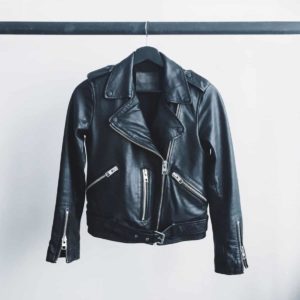A new leather jacket is meant to make you look like The Terminator – a rebellious and ruthless rogue, with a devil may care attitude.
What no one tells you about new leather jackets though is that they can often have you literally feeling like The Terminator – robotic, stiff and slow… like living tissue trapped inside a leather endoskeleton.
That’s because just like with your old school shoes, leather jackets need a period of breaking in.
Famed for longevity and a tough, durable texture, it’s this same strength of material that can make leather a nightmare to wear – constricting your movements and leaving you void of all flexibility.
That’s why most new leather jacket owners are quick to seek out a resolution for their rigid attire, all desperate to learn how they can soften or stretch their cardboard cutout clothing.
And luckily for you, we have the answer.
Leather Jacket Softening Tips
1. Wear It Out
This is not a joke…
We’re genuinely suggesting you wear your jacket more… like all the time.
Obviously breaking in a leather jacket and getting it to mould to your shape is far from fun, but it’s going to happen even more slowly if you only wear it a few times a week.
If you want to break it in faster, the easiest way is just by wearing it on a daily basis, even putting it on around the house when you aren’t doing anything!
We’re not suggesting you perform gymnastics in it, but any activity which involves gentle bending and movement will also help create a little bit more give.
Be careful not to do anything too strenuous or abrasive though, as you don’t want to accidentally cause any rips or tears!

2. Wetter Is Better
If you’ve spent the last few weeks rolling around the living room in your leather jacket and there’s still no noticeable difference, it’s time to seek some less natural forms of softening.
The cheapest remedy is by using a little bit of H2O to bring out the best feel in your jacket as a little moisture often causes leather to become looser and more easily stretched.
Our advice would be to pour a little water into an empty spray bottle, then give your jacket a very light mist all over.
If you don’t have a spray bottle, you could very lightly dab the jacket with a damp washcloth or even just go for a wee walk in the rain provided it’s forecast for a very light shower.
Then once your jacket has a small amount of moisture applied – put it on!
While the jacket has a little more stretch to it, make sure to do some exaggerated movements such as raising your arms, bending over – basically anything which works out the stiff areas. You can keep doing this or just generally wearing the jacket until it dries.
In theory, this should cause the jacket to then shrink and constrict around your shape, breaking the jacket in and giving it a unique fit that’s perfect for you!
The trick here though is to never completely soak the jacket or let it get too wet when applying moisture.
Too much water can strip leather of its natural oils and cause it to become even stiffer when it dries out, hence why it’s not a good idea to put them in the washing machine.
This is why many people treat their jackets with water repellent spray, as it protects them from bad weather.
If when doing this method you ever accidentally spill or apply a noticeable wet patch, just be sure to immediately pat the area down with a towel to avoid prolonged liquid contact which may cause damage.
3. Mint Condition
By far the most popular and safest way to soften leather is with a specific leather conditioning spray.
These are water-based products designed to help you regularly care for your jacket and keep it supple after cleaning.
As leather can naturally dry out over time, you’re best off nabbing yourself a bottle as early as possible, as treating your jacket with the solution every few months will help it stay softer for longer.
Be sure to read the label before buying though, as conditioning sprays are usually designed for a specific grain or type of animal hide, meaning using the wrong conditioner for your type of jacket will not get you the desired results.
4. Other Treatments
If you’re something of a do it yourself chap who doesn’t want to shell out on leather conditioning spray, you may want to try out some of these alternative remedies using unusual products or products you might find around the house.
Alcohol & Vaseline
Dab rubbing alcohol onto the jacket then wait to dry. Once free of moisture, apply vaseline and leave overnight.
Coconut Oil
Leave your jacket in the sun to dry up slightly and then apply coconut oil. Beware though, as coconut oil may turn it a few shades darker if applied carelessly.
Although these have been tried and tested, we obviously wouldn’t recommend them over leather conditioning spray or just a light dab of water – especially if you’re trying to soften a seriously pricey leather jacket!
How To Prevent Leather Jacket Stiffness

Even if your jacket is loosey-goosey now or has become so after treatment, that doesn’t mean it won’t ever become rigid or inflexible again.
Remember that leather is animal skin and so it dries and constricts naturally over time, meaning you should really be taking measures as often as possible to extend the life and quality of this clothing.
Picking The Right Leather
Which kind of leather jacket you choose is always going to have its own unique textural qualities.
For example, cowhide is a particularly rough form of leather, usually used for furniture and motorcycle wear because of its strength. You’re therefore much better off purchasing a deer, sheep or goat skin jacket, with lamb and calf skin being known as particularly soft materials.
The grain of leather can also make a difference, with the finer the leather often meaning the stronger and more durable the material. The aim is to choose something not overly strong like full-grain, but also not something cheap and nasty like bonded leather.
For this reason, top-grain and corrected grain are usually the best choice.
Storage Issues
As you might have gathered by now, leather is a very sensitive material that does not do well in either incredibly humid or incredibly dry climates. Either one can warp or affect the quality of your jacket, so it’s crucial that wherever you store it has an average level of humidity.
Dodgy Drying Methods
You’ve been caught in the rain and your leather jacket is soaked and you’re conscious that this may cause irreparable damage to your beloved hide.
But whatever you do, please fight the temptation to use obvious drying methods!
Things like radiators and hair dryers can actually be really harmful to a leather jacket as they cause fast-acting and hard to control levels of drying, running a huge risk of ruining the jacket’s feel and causing it to stiffen up and harden for the rest of its days.
Instead, simply make it your aim to pat down as much excess moisture as you can with a towel and then leave the jacket to dry naturally on the back of a chair or out in the open – not in a closet or wardrobe where it may pick up mould.




